|
|
ADDRESS AT THE VALEDICTORY FUNCTION OF THE XV INTERNATRIONAL CONFERENCE ON COMPUTING IN HIGH ENERGY AND NUCLEAR PHYSICS (CHEP06)
17-02-2006 : Mumbai
Knowledge Grid
"Science is borderless
I am delighted to participate in the Valedictory Function of the XV International Conference on Computing in High Energy and Nuclear Physics (CHEP06). I greet the computer specialists, physicists, academicians, application engineers and distinguished guests.
Dear Friends
Yesterday night, when I was working for this lecture with my team in my computer, I have witnessed the CERN GRID through the MonALISA Software. What a beautiful monitoring capability. We could able to see the entire CERN GRID connecting various parts of the world including India through a high bandwidth network in a 3D map and GMap. In the load distribution pattern among the computing nodes, I saw Purdue and Star are distributing the load using around 500 nodes. When I saw the on-line WAN Traffic monitoring, I have observed some of the Tier1 and Tier2 GRID Cluster is transacting more than 1.5 Gbps. When we try to analyze, IU-ATLAS Tier2 node from India is running 100 jobs using 200 nodes, whereas the Purdue node is running 250 jobs with 490 clusters. I really appreciate the way in which the GRID monitoring tools has brought the activity of the GRID into a reality. Also I feel the time has come, for India to enhance the bandwidth immediately, I understand 622 mbps minimum is essential for the CERN ? INDIA connectivity, whereas a nation we need to aim at gigabit connectivity. Hence I have a dream, ?on-demand access to bandwidth is available free of cost to the needed users?. Because the bandwidth is the demolisher of imbalances and a great leveler in the knowledge society.
Making the bandwidth available is like the Government laying the roads. Movement of materials through these roads creates wealth in the industrial economy and the government recovers more than the investment on the roads by way of taxes and enhanced prosperity of its people. In the modern digital economy driven by knowledge products, bits and bytes traverse the network and create wealth and this will recover the cost of investments in the bandwidth. Presently, in India the network is already there. It has only to be lit up and offered to judicious users. If this is done, I am sure science, technology, and economy will go in a ascending trajectory leading to faster societal transformation and national development.
My experience with TIFR
When I am with TIFR, I recall two incidents, which are very dear and near to me. First one happened in early 1962. I was interviewed in this campus in one of beautiful rooms of TIFR, by Prof. Vikram Sarabhai, Prof. MGK Menon and Mr. Shroff, a Government representative. To my great surprise, the interview took one hour and all the questions asked were to find what I know and what my experience was in the development of hovercraft rather than what I did not know. Just a month before that, I had piloted Prof. MGK Menon as a passenger in an hovercraft developed by us in ADE.
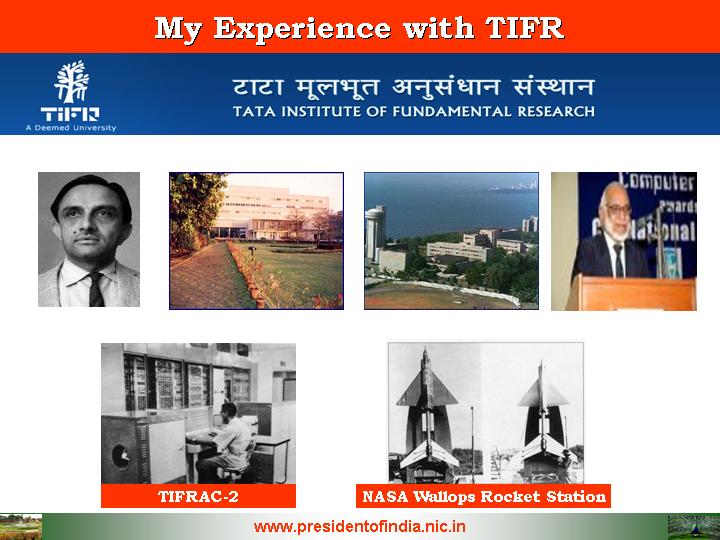
Immediately after the interview my selection as a Rocket Engineer for the Space Programme was communicated to me by Prof. MGK Menon. Before going to NASA's Wallops Rocket Station, Goddard Space Flight Centre, Maryland, USA, I was posted to the Atomic Energy Establishment at Trombay (Today it is BARC). The first assignment given to me was to work with TIFRAC computer team. TIFRAC was at that time was under development and certain capabilities were in operation. After visiting TIFR many times, I realize that TIFR Scientists do think differently and make original contribution in many areas of fundamental science and their contribution over the 60 years to the fundamental research in science is important and significant.
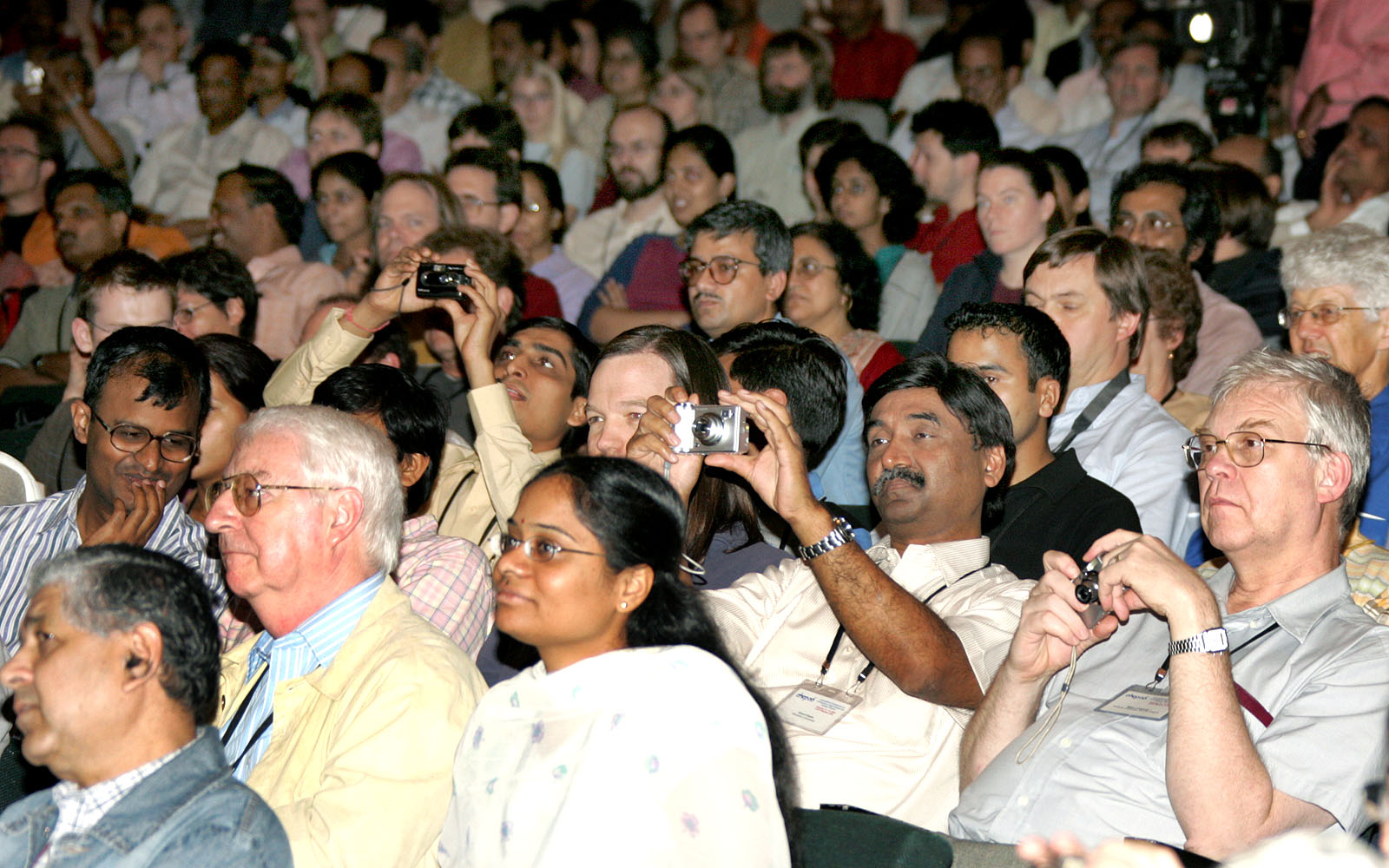

Graduating towards GRID Computing for R&D
In the early eighties India embarked upon a mission to develop supercomputers to meet the growing demands of the DRDO, ISRO, DAE and our academic Institutions. This is the
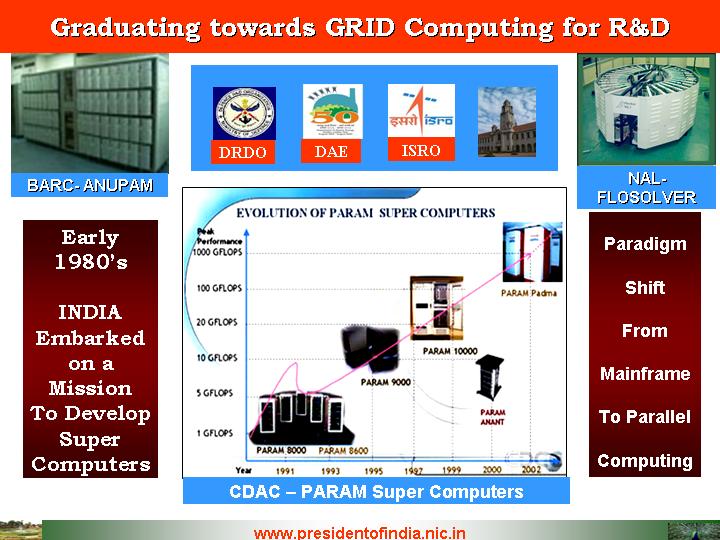
era of denials and mainframe and vector processing supercomputers. This mission mode approach resulted in the development of many indigenous supercomputers such as the PARAM of CDAC, ANUPAM of BARC, ANURAG of DRDO and the Flowsolver of NAL and also in the establishment of many state of the art supercomputing facilities at places like the Indian Institute of Science and the National Centre for Weather Forecasting. This also heralded the beginning of the RISC processors and a paradigm shift from the dinosaurs of mainframes to parallely connected small but powerful microprocessors. India also developed the capability to design its own processors. The networks were still slower and unaffordably costlier in those days and hence we did not attempt to interconnect these supercomputers. The users mainly used slow speed lines to log in to the supercomputer or often went physically to the facility to use the supercomputers.
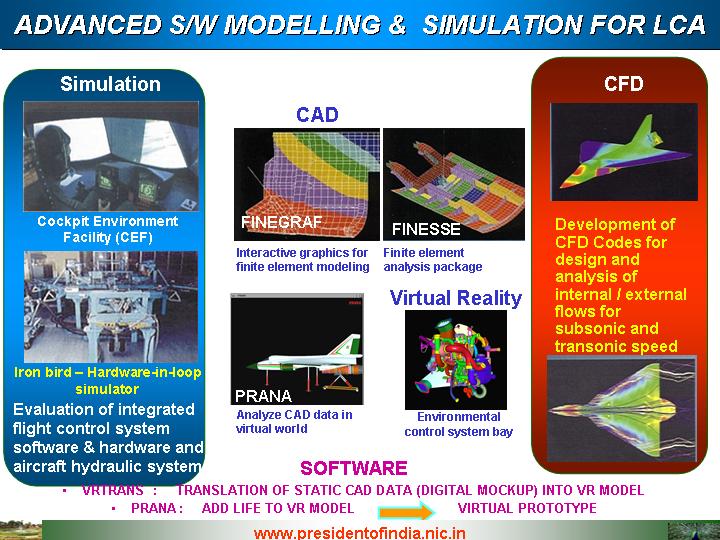
DRDO, ISRO and many other organizations created their own virtual laboratories- notable amongst them are the ability to make a virtual wind-tunnel using hypersonic CFD codes to design spacecraft. The trend in those days was to see if we can completely do away with experimental facilities and try and do simulations all the way. Worldwide and in India these trends were driven by engineering applications dominated by defence requirements and scientific applications dominated by weather forecasting, molecular modeling and high energy physics. What are the changes that have happened since then that has motivated us to move from parallel processing to GRID computing?
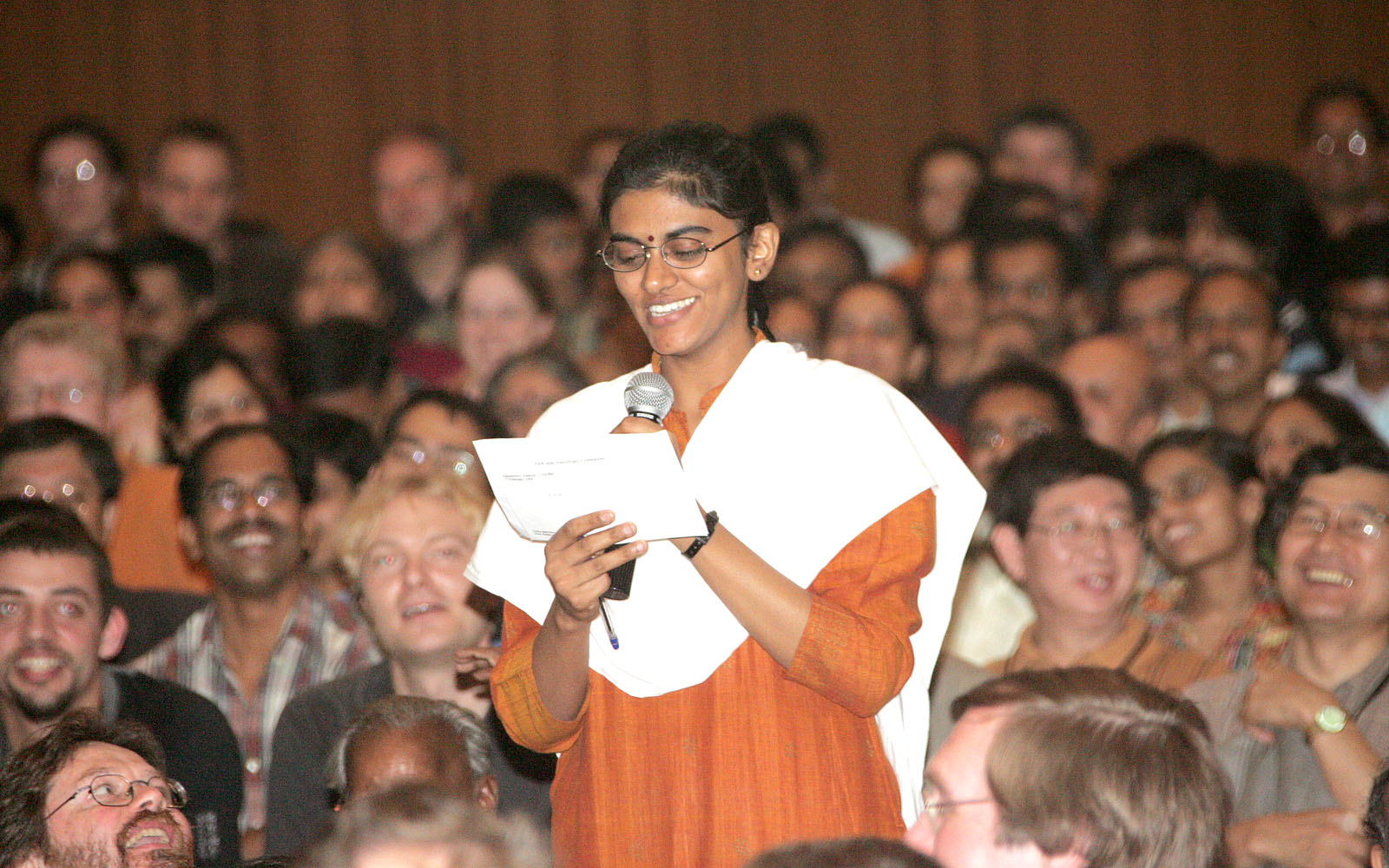
Towards GRID Computing: Recently, I had invited the leading scientists working in Nano Science and Engineering to the Rashtrapathi Bahvan to chalk out the national road map
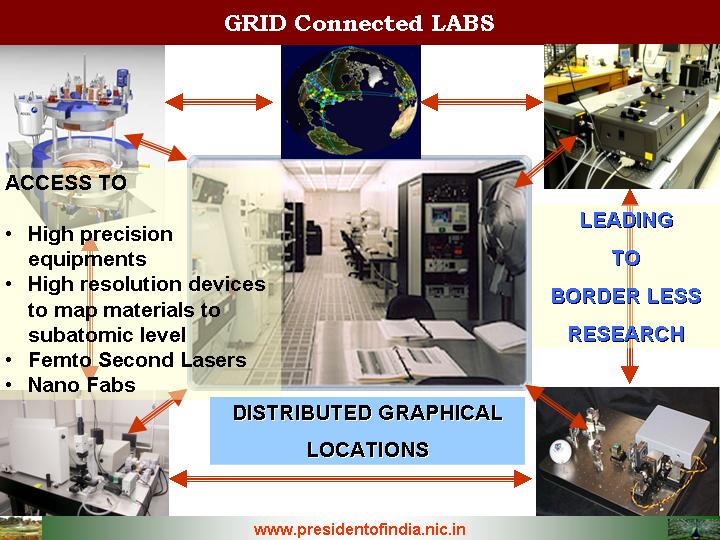
in this area of importance. What came out of the discussions is the stunning plethora of high precision equipments that are needed for research in this area. These equipments are high-resolution devices permitting us to map materials at subatomic levels, create massive amounts of data and are very expensive to install and maintain. The same is the issue in areas such as laser physics where today we talk about femto second lasers. Today in order to work in such leading areas one must have access to such equipments irrespective of one?s geographical location. Science is going to be equipment intensive and will become part of the simulations. The world will witness a convergence of the use of equipments with high bandwidth data and simulations by very powerful supercomputers all working coherently to carry out remote research or borderless research- a research that does not depend on the borders between areas of science and engineering nor does it depend on political borders. The computing challenges will now come from fundamental sciences equally as from applied sciences.
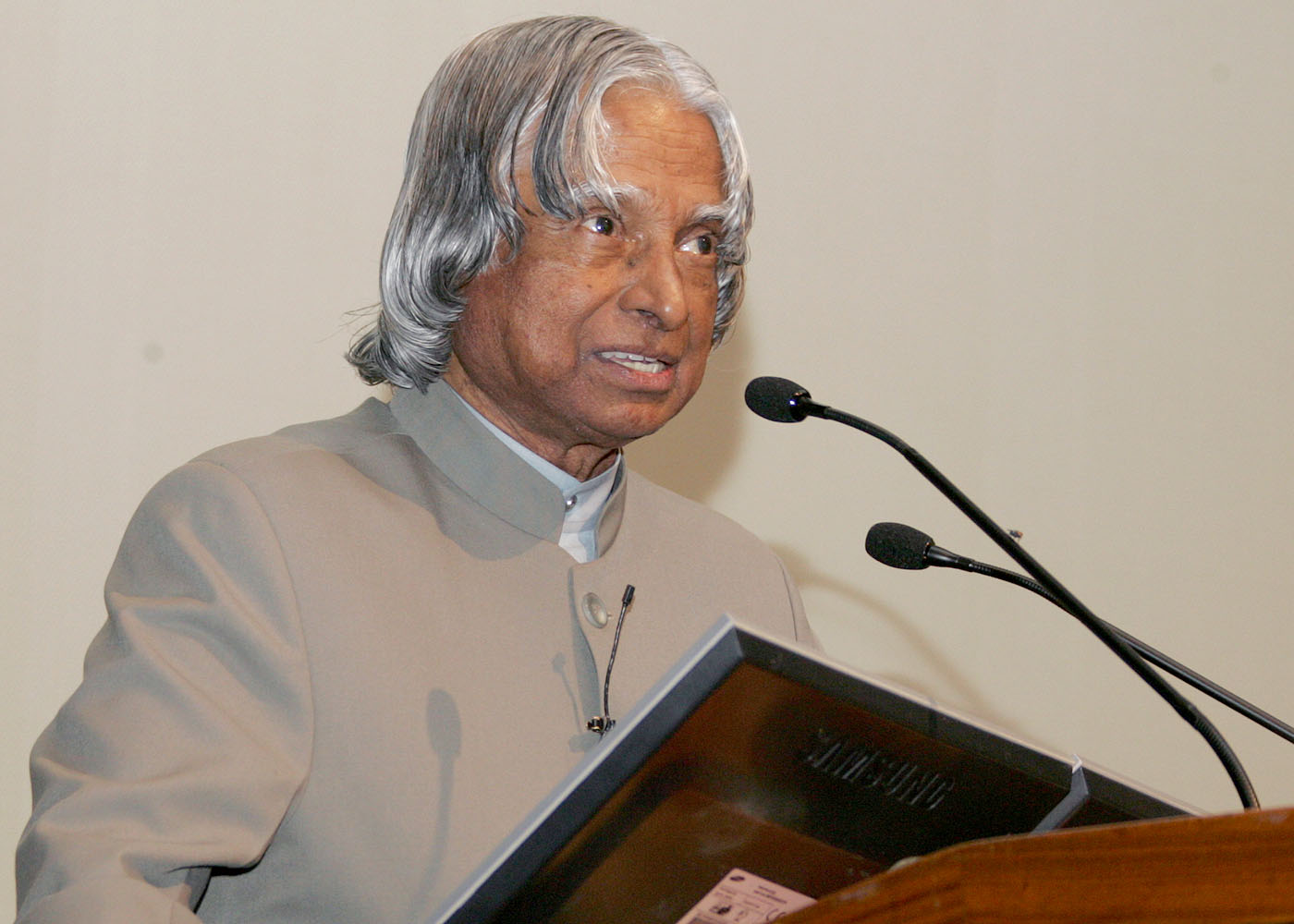
Network and Bandwidth: Next, the revolution in bandwidth has made the interconnections of not just a few processors over a few meters distance but many supercomputers across the continents. Even in this respect India has forged ahead and in fact the fiber is available in abundance across the nation and Indian corporate such as VSNL and Reliance own a major part of the fiber outside of the country as well.
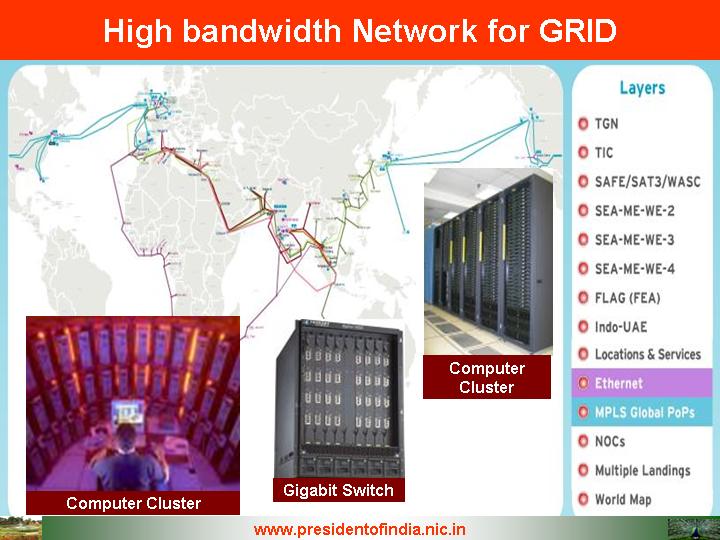
The third change is the emergence of very high power off the shelf hardware such as the PCs and Gigabit switches and software to connect heterogeneous systems to look and feel as a homogenous and monolithic computer. This revolution has made making Clusters of computers from Common Off the Shelf (COTS) hardware and software to give supercomputing powers at affordable cost even by a small college in remote parts of India.
The tremendous strides in computing and high quality instrumentation can only be harnessed for the growth of humanity only if we connect all our resources, not just the computers but also the equipments, data and information on the grid and ensure that all of this is available on demand to any one at any time. Only then we can reap the benefits of science to create more science and community of scientists who collaborate, create and innovate. The GRID, my friends, is not just an interconnection of computers but also an integration of everything that we do in science including the networking of the scientists and the scientific minds.
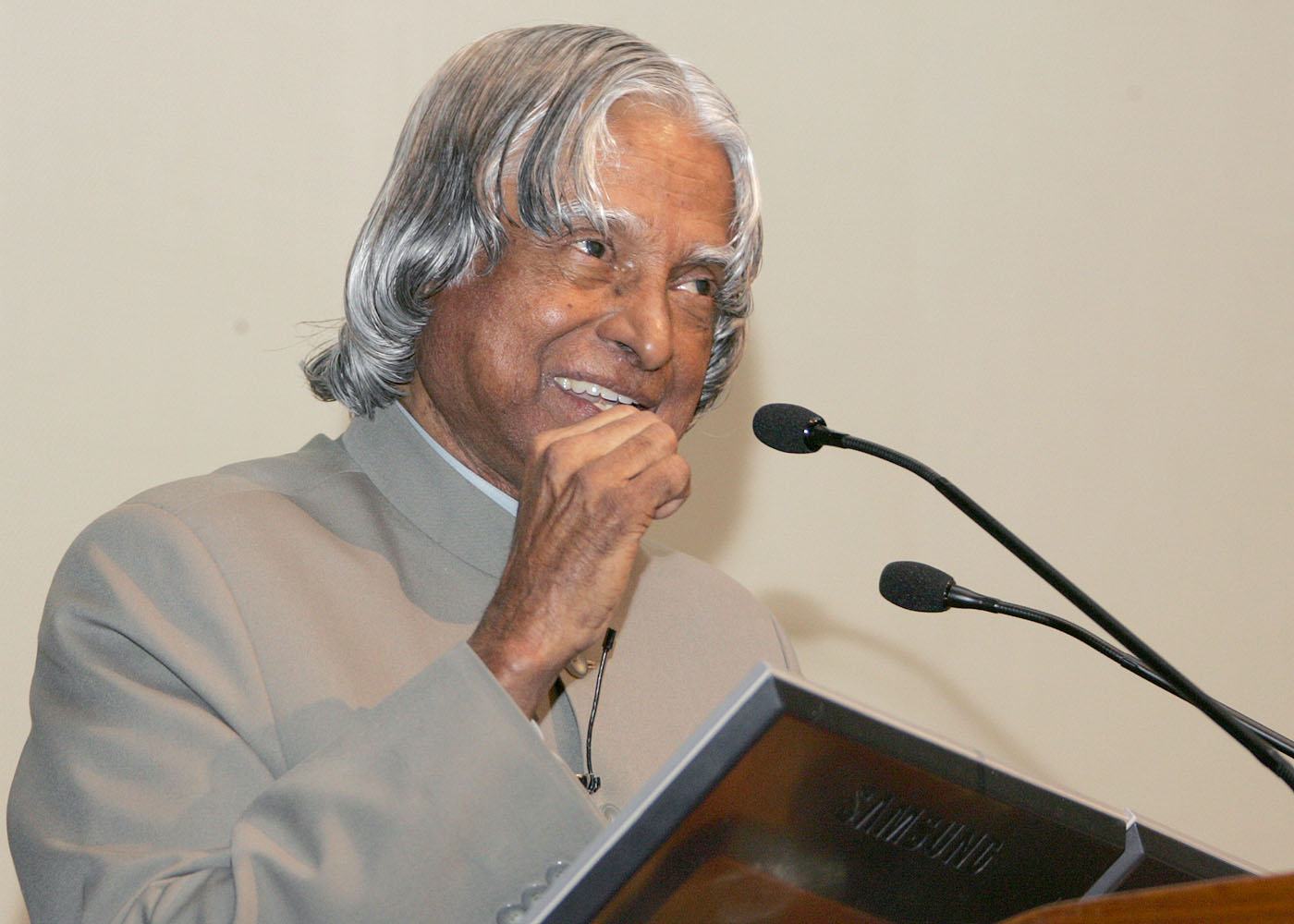
When I am thinking of GRID in the TIFR campus while participating in the Valedictory Function of Computing in High Energy and Nuclear Physics, I am reminded of my recent visit to CERN, Switzerland.
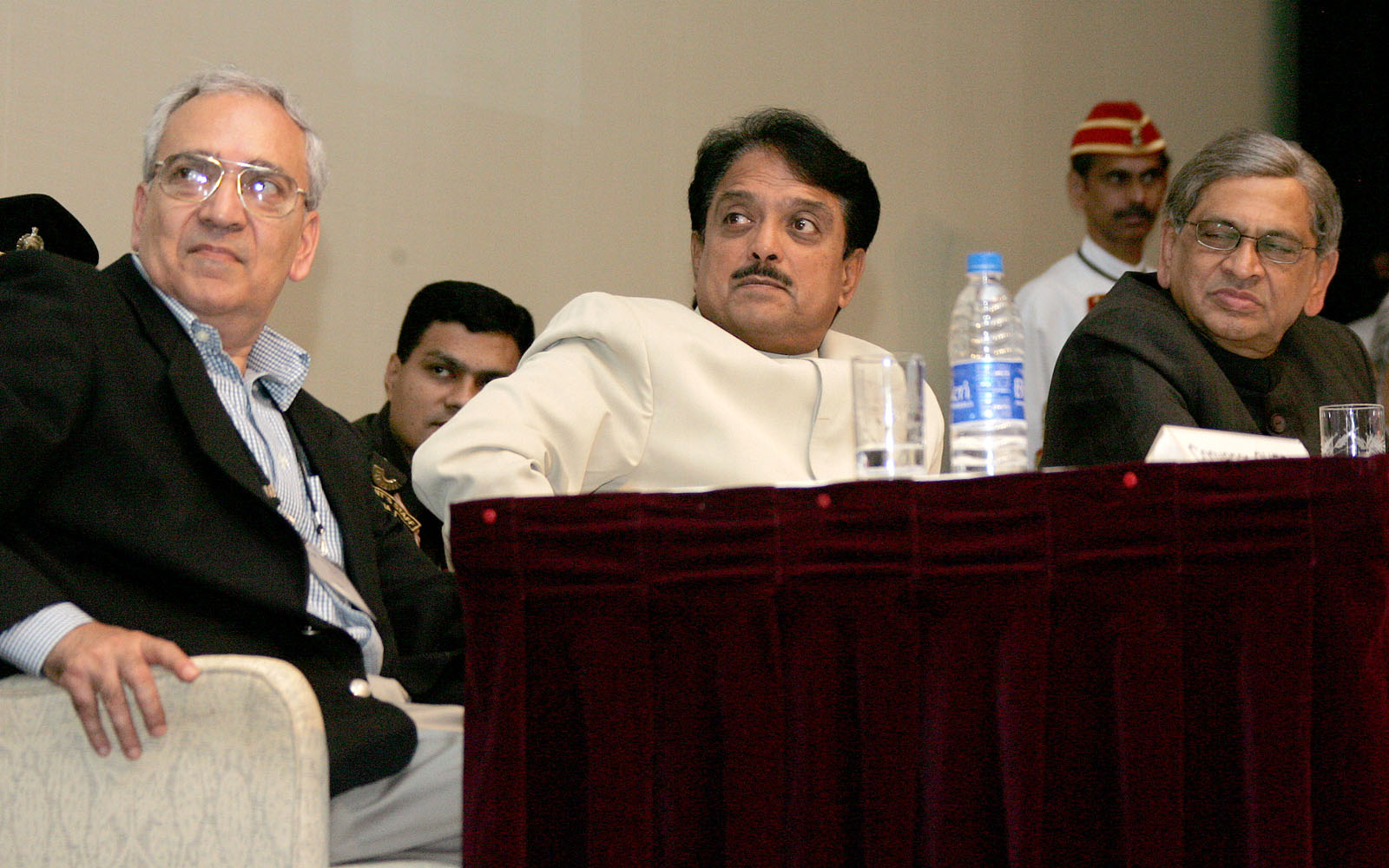

CERN and India
In CERN, I witnessed construction of largest accelerator, Large Hydron Collider (LHC) in the world. I met Dr R. Aymar, Director General of CERN and discussed with him the areas of common interest. I am very happy that interactions between India and CERN are spilling over beyond ? the LHC - into new Science. One important development over last two decades or so in the basic science is the ?mega ? science? or science by large collaborations where number of collaborators goes up from hundred to thousand for example in experiments done on large accelerators. The collaborations range from one continent to another. Several Indian Institutes including
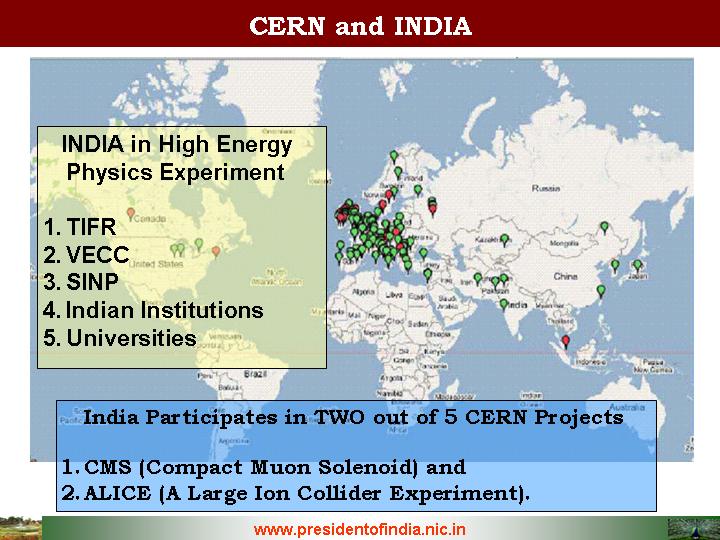
TIFR, VECC, SINP etc. are actively involved in the mega-science projects like STAR at BNL and LHC at CERN. Indian scientists are building large detector systems, so we also pay enough attention that we take part in data analysis and extraction of physics information. I am confident; CERN is doing great service to the mankind by building LHC, which would allow new discoveries in Physics. I am very happy to see that the Indian scientists are participating in two of the five projects, namely CMS (Compact Muon Solenoid) and ALICE (A Large Ion Collider Experiment). In these large experiments, apart from path breaking developments in the areas of detector technology, electronics, instrumentation etc. there is one area where present technology reaches a road block, that is handling of Terabytes amount of data & hundreds of Teraflops of computing power. The need of working with the data at very high speed and by large number of people makes the issue even more problematic. Getting this huge amount of computation need at one place is just impossible notwithstanding, tremendous progress made in Computing & Communication technology.
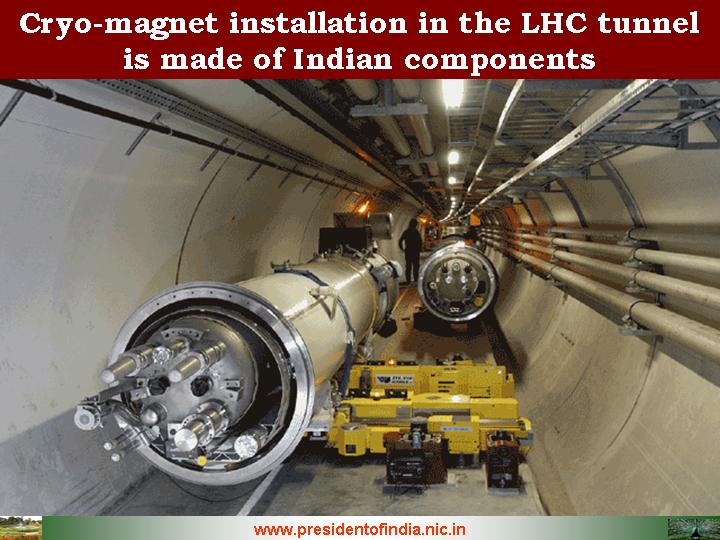
CERN has established the GRID with 622 mbps network between the participating nations using their computing through Internet in 4 tiers. This is not just connecting computers around the world but it is a technology where one needs to deal with the problem of connecting heterogeneous systems & connecting them at high speed so that they break the barrier of distance, and most importantly dealing with all-important security in the present connected world.
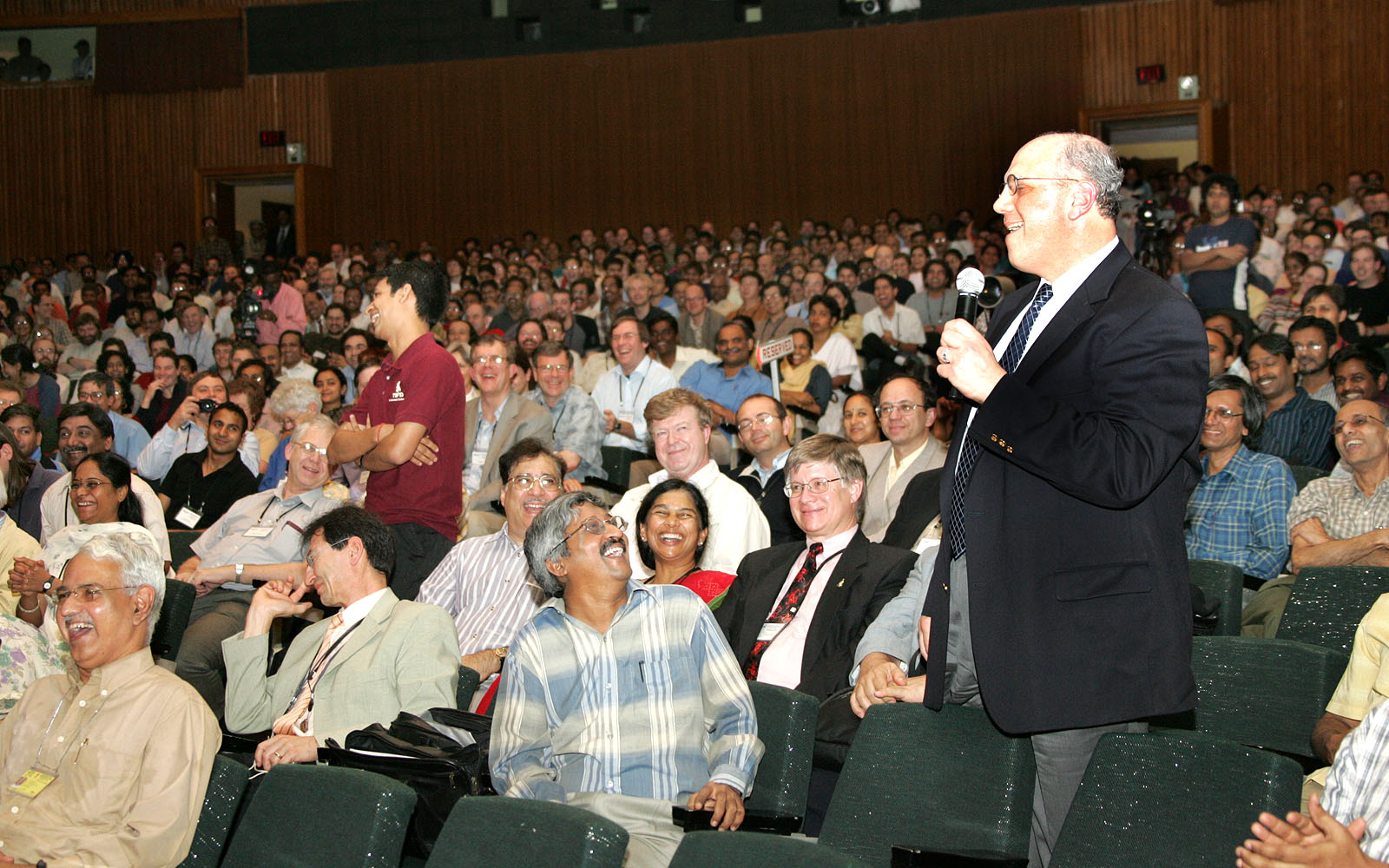
DAE GRID: I must also mention that, DAE together with DST has taken a lead in CERN collaboration, contributing in
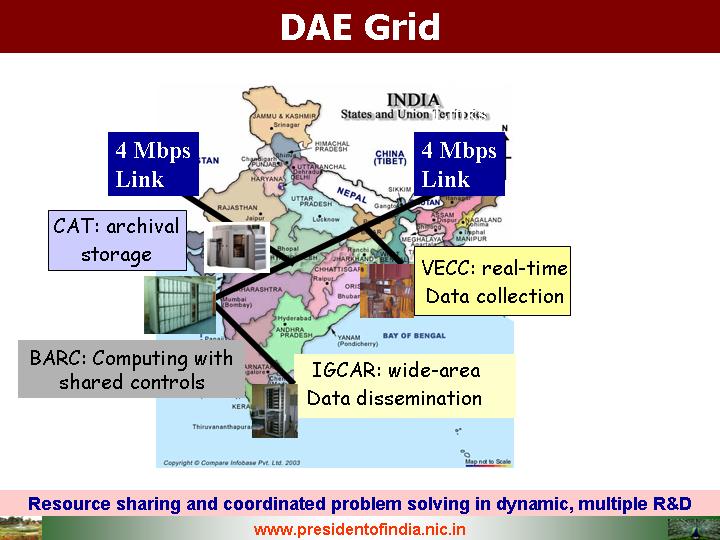
many areas. DAE is also actively involved in the design, development and supply of LHC magnets, Power supplies, LHC control software, Data Acquisition System, detectors at CERN for the past few years. To support researchers with required infrastructure, India is committed to setup regional Tier-2 of
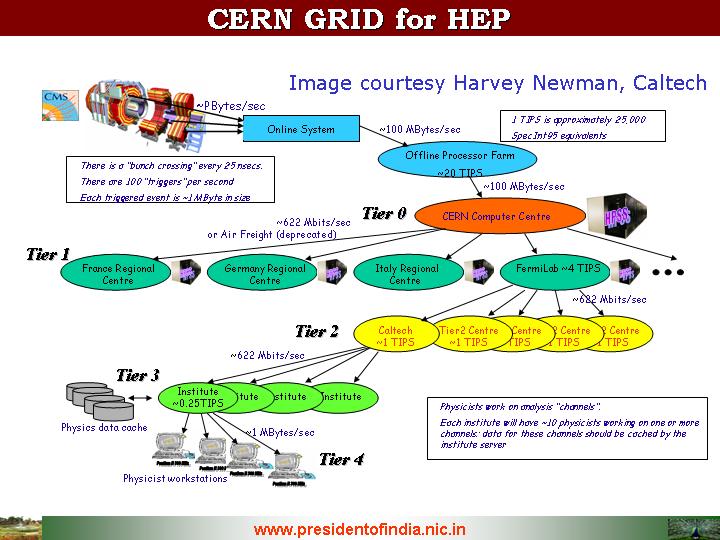
CERN. This center would provide access for various Universities and Indian collaborators, LCG Data Grid services from India. I understand that Tier-2 regional center will be operational at TIFR, Mumbai with 622 Mbps (currently operational at 34 Mbps) international leased link to CERN by 2007 to cater to CMS users, which in turn will have 100 Mbps gateway for ALICE users at VECC Kolkatta and there will be number of TIER-3 centres with 8 Mbps links located at user?s premises across the entire country. DAE has developed number of Grid based Tools in the area of Fabric management, AFS file system and Data Management, which are being deployed by CERN in their phase-I of LHC Grid operations starting from July 2003. DAE is gainfully utilizing the experience & expertise obtained during CERN collaboration in
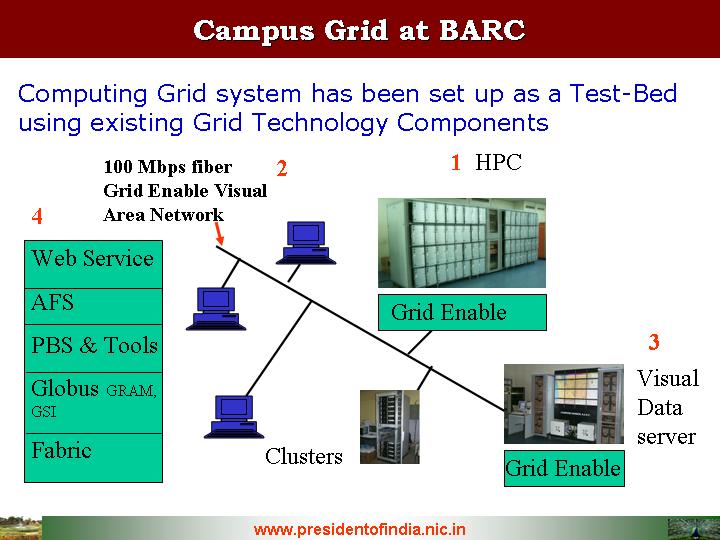
developing country wide DAE-Grid for sharing data collected from Seismic, Environmental, Gamma-ray astrophysics and emergency control applications.
I visualize that very soon, I will be able to see scientists sitting in TIFR conducting an on line experiment in the LHC at CERN and analyzing the data in real time or an aeronautical engineer in Bangalore comparing his CFD code with the real time experimental data coming from a wind tunnel in the US. That will be the grand challenge for the GRID community today.
So far, we have discussed the GRID computing requirement for the R&D and scientific community. I visualize the GRID connectivity for the society in the same lines, where the connectivity is the focus that ensures the seamless flow of information across the various connected GRID leading to societal transformation.


Connectivity Model
The core of this connectivity model for Electronic Connectivity for prosperity of one billion people is the partnership between governmental and multiple institutions in
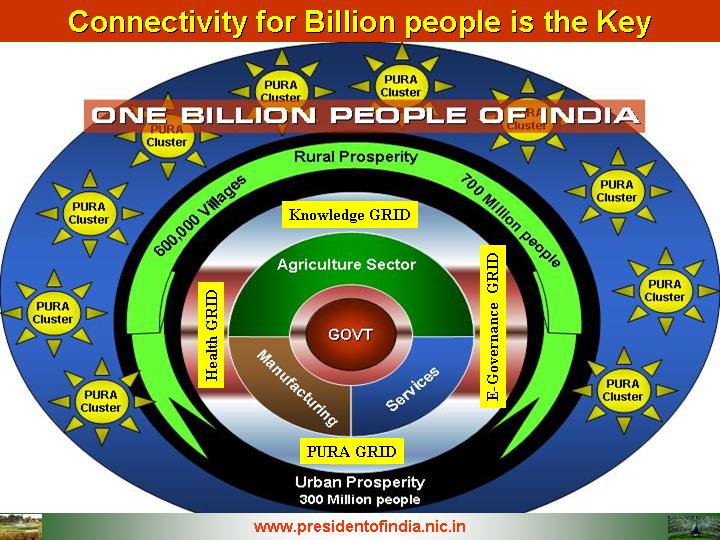
the public and private domains. The strength of this partnership for collaborative growth and economic prosperity is facilitated by free flow of knowledge and information in a seamless manner cutting across levels and boundaries embracing all walks of life in the three sectors of the economy such as Agriculture, manufacturing and services sector.
In this model, four grids bring about the interfaces of
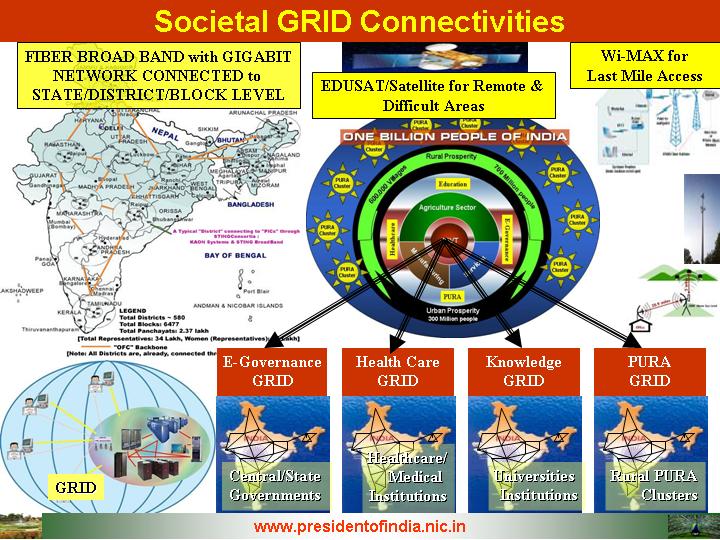
three sectors of the economy: namely, Knowledge Grid, Health Grid, e-Governance Grid and the PURA Grid. Each grid is a system of multiple portals. The aim is to maximize gross domestic production and productivity of the land and people through maximizing the performance of each sector, synergized by the system of inter and intra-sectoral electronic connectivity to serve one billion people. This will bring prosperity to 700 million people in the rural areas and 300 million plus people in the urban areas. In the process, it will ensure that the lives of 260 million people will be uplifted from below the poverty line. Let me now focus only on knowledge GRID.
Knowledge GRID: In the world of Virtual Universities the equitable access to all its participants is the primary goal. Unlike in the real world, the equitable access is always the
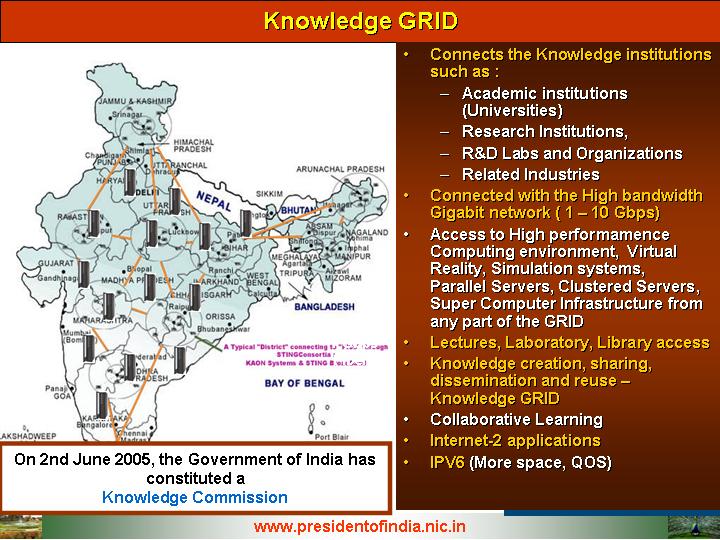
democratic average, in the Virtual Universities the equitable access always means the equitable access to the best resources ? be it the teachers, be it the library, be it the laboratory, available across the network. In effect, the network brings the best of its participants to every one of its participants. The three phases of learning are the lectures, library and laboratories. They require increasing bandwidth from a few 100?s of kilobytes for the lectures to a few megabytes for the formal digital libraries and the informal world of knowledge from the Internet, to gigabits of connectivity for remote laboratories in the world of high precision science and engineering. As the bandwidth becomes cheaper and available in abundance, universities should be able to run remote instruments and facilities as complex as NMR to Wind tunnels. These are applications that can make a difference in how we engage in teaching, learning, and research in higher education.
Internet2: The world is moving towards internet2 applications. Internet2 applications require advanced networks. That is, these applications will not run across commercial Internet connections. Internet2 applications require enhanced networking functionality?such as high bandwidth, low latency (delay), or multicast?not available on our commercial Internet connections. Internet2 is about everything we do in higher education. Therefore, we encourage and support applications development in all disciplines from the sciences through arts and humanities. Whether you're in the classroom, the laboratory, the library, or the dorm, you should be able to access Internet applications that provide benefit.
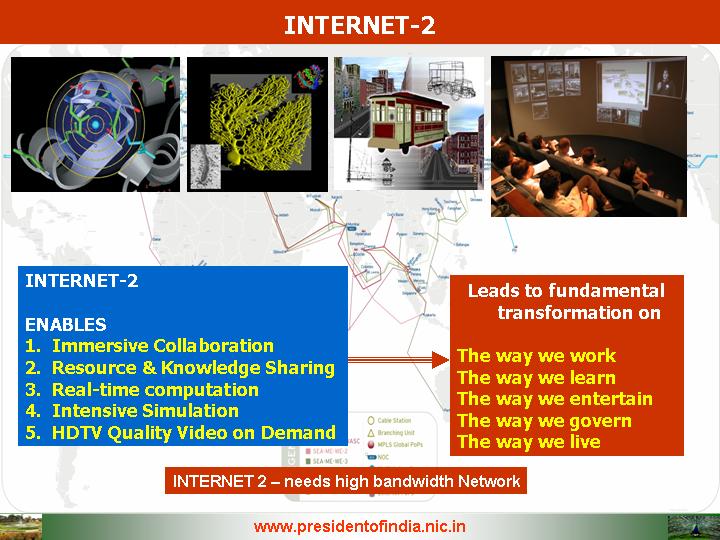
This will ultimately provide equitable access to the entire education system beyond just the lectures and the lecturers. We have rich knowledge institutions but what we have to add is connectivity. This connectivity today is technologically possible but would need creation of high bandwidth reliable network infrastructure to the extent of minimum 1 to 10 Gigabits per second all through the country to provide uniform access of knowledge in different regions leading to the creation of Knowledge GRID. Making the bandwidth available on demand and accessible at any time has been considered as the demand and supply side of economics. Many things are not done because it?s too hard, takes too long, and doesn?t have the capabilities, costs too much. It is essential to remove the barriers and open up the gates of innovation. We have very bright young people in universities, and bright faculty, but they are throttled in what they can even attempt. Hence, it is necessary to build the necessary capacities among them, remember we are training the next generation.
I am very happy that the MOU between Internet2 and CDAC & ERNET is being formalized in this conference, to jointly collaborate on the development of next generation Internet technologies and applications. It represents a significant step forward in establishing India as a key participant in the Global Knowledge economy. It is one of the main pillars on which India's global leadership in innovation, quality and opportunity for research and education will be built. It is important to recognize that while we think typically of Internet high performance networks only in the context of advanced research, they are critical infrastructure for educational quality and access. The internet2 will transform the messaging and collaboration paradigm to Virtual Laboratory Experimentation in the GRID connected world.
The planning and implementation of the workshop itself exemplifies the global collaboration and cooperation required to realize the end-end value of these advanced networks: Scientists in the US and India, TIFR, CDAC, ERNET, Internet2, the Ministry of Communications and Information Technology, IEEAF, and India's National Knowledge Commission have put their shoulders together to make this event happen.

Research Missions for the CHEP06
So far I have discussed with you about GRID connectivity and Internet2 initiatives. Now let me now discuss what will be the focused missions for the High Energy Physics Scientists assembled here. During the last six decades of its performance, TIFR has carried out internationally acclaimed basic research with its activity spanning from all branches of natural and mathematical sciences and science education. It is also the birthplace of numerous institutions, which are now engaged in the frontier activities of applied sciences and technology in the country. With this experience I would recommend the following missions for TIFR in collaboration with the High Energy Physics Scientists across the world during the next two decades.
a. Mission for Computers in particle physics: One of the greatest challenges that would be met by the computer scientists working in such long term programmes as the LHC is the design of computing environment that are robust and do not become obsolete fast. The data from LHC is expected to flow for the Proton-Proton collisions in the middle of 2007. I believe the world community would carry out the analysis concurrently. When will the major results exposing any deviations of the Standard Model start coming in?
As you are all aware the computer and communication technology is extremely fragile and obsolescence is the way of living in this fast moving technology. The lifetime of the computer of latest architectures is less than five years. Within a period of ten years the storage medium and the format also change. I am sure with the best brains from India and international organizations assembled here; we would be able to find a long lasting solution to this problem. Your discussion results will be useful to the whole world of information scientists and physicists.
b. Mission for Space research and particle research: India has built a network of satellite as well as ground based experimental facilities for understanding particle physics phenomena and space research over the last 40 years. Research from space science activities has included many topics. A few of them are:
* Detection of black hole event horizon.
* X-ray emission from Jupiter, electro jet phenomenon.
* Discovery of short-lived nuclide in early solar system.
It would be worthwhile to consider the possibility of integrating the data from accelerators, the scientific simulations and the space and ground based observations.
c. Mission for Energy: The knowledge that you have and will be gaining in building LHC and the results that you will have, will be of great utility to many technology ventures in the world. Based on India's participation in the LHC programme, our knowledge base towards using technology for energy independence should get enhanced particularly in the development and production of thorium based reactors.

Conclusion
In order to make the country the most advanced knowledge society, we should aim at making the bandwidth available without hindrance. The GRID initiatives across the world should aim at making the computing, equipment and human resources available to every one on demand with no distance or time barriers. If this is done, I am sure science, technology, and economy will go in an ascending trajectory leading to faster societal transformation and national development.
My best wishes to all the participants of this Conference for success in their mission of removing the digital divide among the scientists located in different parts of the world leading to path breaking discovery in the area of high energy and nuclear physics.
May God bless you.
<<Back
|
|